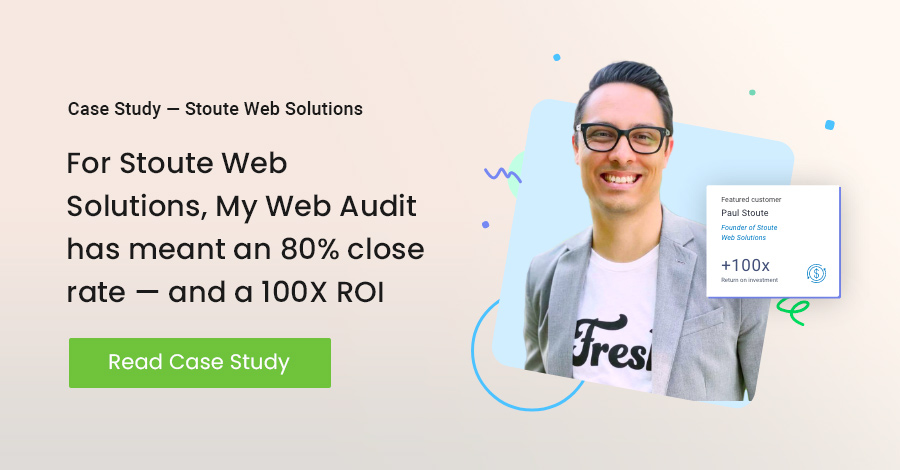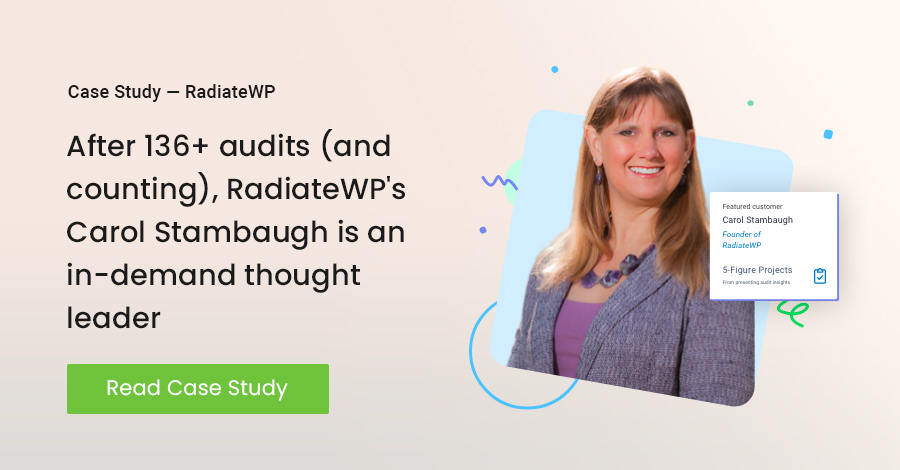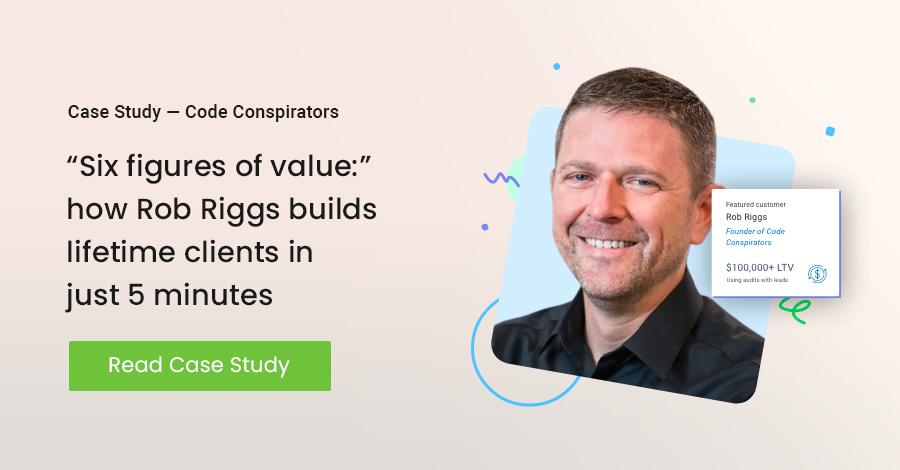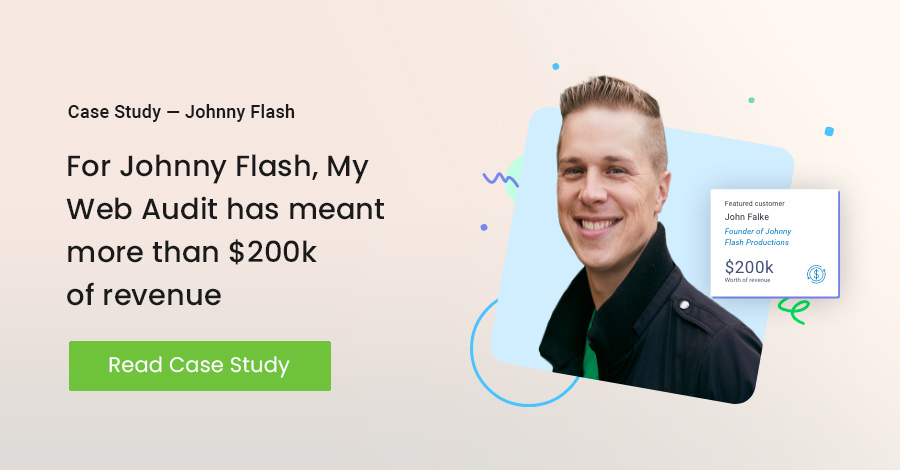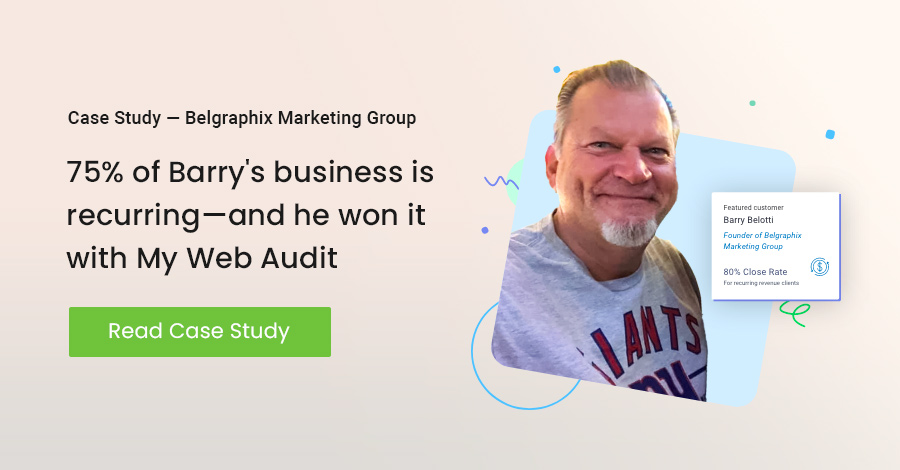
v4 Agency Sales Framework
I don't consider myself great at sales. I don't have a way with words like some of my fellow agency owners do. And yet I regularly close five-figure deals and the occasional six-figure deal.
How is that possible?
Simple: I avoid the "slick salesman" talk that some agency owners use. Instead, I position myself as a trusted advisor, and I lead with value.
I don't even have to "sell" my agency services. All I have to do is show leads that:
- I understand their business and challenges and can help with their desired outcomes.
- I hear their concerns and can relate.
- I have the expertise they need to solve their problems or desired outcomes.
And now I'm going to show you exactly how to use this sales framework.
Let's get started.
Table of Contents
Lead Meeting Prep Work

It is important to realize that not every lead is a good fit for your agency. That’s why you’ll want to work on a presale qualification process.
As part of our qualification process, we ask our leads questions that are designed to get at the following types of information:
- Their biggest problems.
- What is their problem costing them?
- What would it look like to solve that problem?
- Why they’re looking to solve this problem now?
- How much they’ve invested in services like SEO or their website, etc., in the past 12-24 months?
- Why do they want to work with us now?
The email I use when I request that the lead fill out our intake form is designed to position us based on authority, demonstrate that we deliver results, and provide some social proof. Then we ask them to fill in the form, which only takes a few minutes. We want to make it simple and easy to fill out and tell them why it benefits them to do so using copy like this:
“This is your opportunity to tell us more about your project and your desired results. The more information you provide us here, the better our solution.”
The second thing we do is send them a playbook. This is a beautifully designed document that talks about who we are, the results we’ve achieved for other clients, and basically why the lead should want to work with us. The playbook also includes general price points and ranges for most of our services.
The goal of our lead qualification process results in me speaking to about 20% to 25% of the leads who contact us. This means we’re only speaking to the most qualified leads we believe we can help and that afford to invest in our services. This is why we close 75% or more of those leads.
Once the lead has filled out our intake form and scheduled a strategy call with us, we begin our sales prep.
I begin by reviewing the intake form responses to uncover the lead’s biggest pain points and desired outcomes. I then identify the audits I can best use to bridge the gap between where the lead is and where they want to be. It takes me 5-10 minutes to run the reports I need and identify what talking points to use on the strategy call. This step is one of the most important ones in helping me quickly deliver value, establish my expertise and help me show vs. tell a lead how I can help them.
I also want to learn more about whom I’m speaking to. I’ll often do some research on Google, LinkedIn, and FB to get a better feel for who they are. For example, is the person I’m speaking to family-oriented? Knowing this sort of information helps me connect with the lead personally.
Hopefully, this gives you a good idea of our pre-meeting prep work process.
Next, I’ll discuss the overall structure of my agency sales process and framework.
My Agency Sales Framework

I believe it doesn’t matter whether you’re getting dozens of leads a month or you desperately need more of them. You need to be able to show all your leads that your company is the one they should be working with.
Over the last 2 decades in the agency sales process, I’ve learned that you need to quickly establish your authority, build trust, and demonstrate your expertise, so you can increase the chance of closing the sale. Simply put, unless you deliver enough value and show them you are the expert they need, you run the risk of losing the lead to a competitor.
With the V4 Agency Sales Framework I created, currently use in my agency, and that I am about to teach you—Visibility, Value, Vision, and Validation—you’ll be better able to build authority, deliver value and close more deals.
So let’s get started…
My strategy calls are usually about 30-40 minutes max. Since they’ve already decided to speak to me, I want to make sure I make the call about them and deliver tremendous value. I generally take 2 minutes to review some of the information covered in the playbook if they haven’t reviewed it.
I use the remainder of my time on the call to focus on their business, needs, wants, and desired outcomes and use that information to help me close the deal. Here’s an overview of how I do that using my V4 Agency Sales Framework.
- Get VISIBILITY into their problems / desired outcomes. Most leads will say, “I need a new site,” or “I want more traffic.” But that’s only the presenting problem. It’s my job to ask the right questions to get the lead to provide visibility into the real issue.
- Deliver VALUE. Leads are sick of being pitched, and they can see a “taker” from a mile away. That’s why I aim to deliver incredible value in my sales process. The easiest way for me to do that is to help my leads see what’s in “The Gap” between where they are and want to be.
- Provide a VISION of a better tomorrow. My focus at this stage is to focus on what actions will deliver the results. I create a vision for a better future by showing them what to fix, when, and why they should act now.
- VALIDATE their objections. When you make your leads feel heard, they’ll stop thinking about you like a slick salesperson and start thinking about you as a collaborative partner.
In the next section, I’ll be sharing the specifics of my V4 Agency Sales Framework and how you can use this framework within your sales process to close more deals.
Let’s take a closer look at each of these four components in more detail…
Visibility — Help leads see what's in "The Gap"

When a lead approaches you, they may say things like “I need a new website” or “I want more traffic.” What they’re doing is presenting a problem to you, but it’s up to you to get visibility into their real issue.
Identify your lead’s pains points and their desired outcomes. The gap between where they are now and where they want to be is the key; provide visibility into that gap—and how your lead can eliminate it—and you’ll close more deals.
To do this, you ask questions such as:
- What is your primary goal?
- Why is that goal important to you?
- What’s gotten in the way of achieving it?
- What does it cost your business, and why?
- What would solving this goal look like?
- What do you want to accomplish on this call?
It’s the real problem you have to get to. There’s a problem-solving technique called “The 5 Whys”—when you ask Why five times you can usually get to the root of any problem. And if you pursue that approach with your lead, you can typically get at what their real problem is—not just the one they’re presenting to you.
It’s not enough to say..
Thank you, Mr. Lead. Let me tell you about how we build websites.
You need to find out why they want one.
Q: Mr. Lead, why do you want a new website?
A: Well, nobody’s calling us.
Q: Why do you think that’s happening?
A: Well, because when you search our name we don’t come up.
Q: “Why is that important?”
A: “Because our sales are down 30% this year and we need to get them back up.”
Q: Why do you need those numbers up now?
A: Because this is the third year that sales have been down, and the company is really starting to struggle.
Q: So why will a website help?
A: Because we’ve had to let half of our sales force go, so we can’t bang on doors like we used to. We’re really counting on this site to make up for the shortfall.
What you’ve done there is given this lead visibility into the real problem.
That’s worth solving and charging for the value you will be delivering. You’re going to be educating the lead.
For example, you might ask enough questions to ultimately determine that the business wants to generate another $300,000 in revenue this year to make up for a slump in sales, but they’re telling you that they want to spend $6000 on a website. With this information, you are able to have an honest conversation about how realistic it is to invest $6000 to generate an ROI of $300,000 each year.
Depending on how they respond, you can either educate them about what is really needed as far as strategy and investment in your services to deliver the desired outcome and help them realize for themselves that they have unrealistic expectations and that they need to change their expected investment – if not, you might realize they’re not going to be a good fit for your agency and you can then decide how you want the rest of the conversation to go and for how long. By qualifying your leads ahead of your meetings, you will significantly reduce the chances of wasting time speaking to tire kickers and price shoppers who look at your agency services as a commodity and are looking for the lowest price.
Here’s the next V in the V4 Sales framework.
Value — Make your time "matter" by delivering value
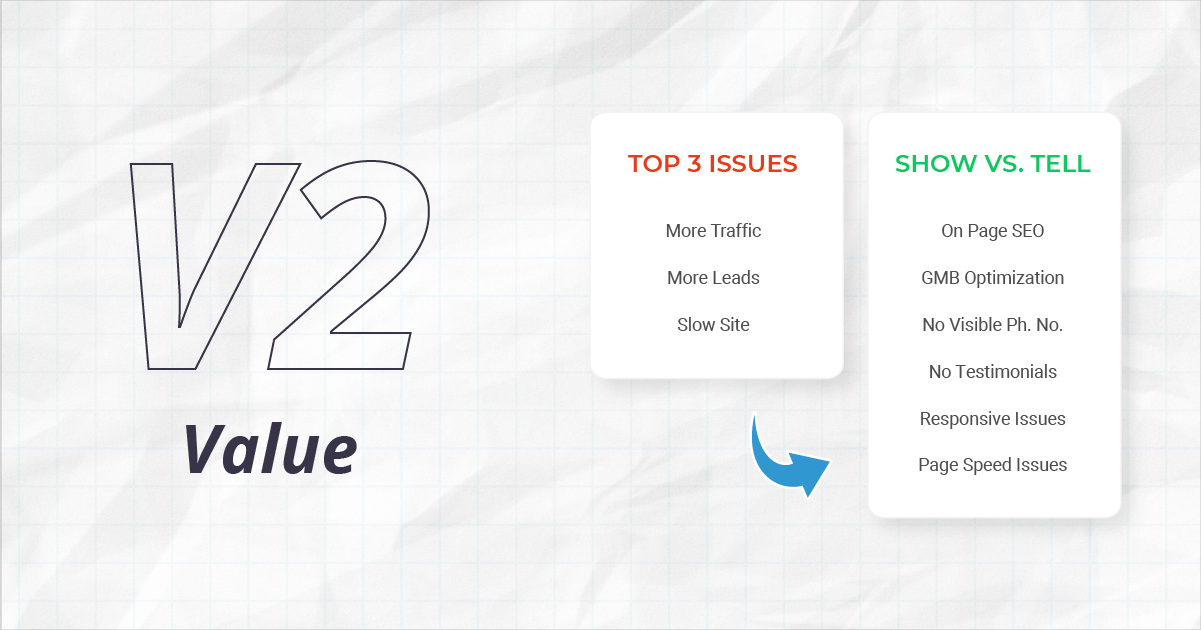
Leads don’t want to work with people just looking to take. They want to work with people who are willing to give genuine Value first. One of the best ways to deliver Value in your sales process is by showing your lead exactly how to solve their problems.
First, to connect with my leads, I translate their stated needs and wants into two or three key issues. Then show them what the problems are and how our agency can solve those problems. I can identify my lead’s top two or three key issues based on the intake form responses or how they answer the questions I ask in the visibility stage (outlined above).
The key here is to show and not just tell your lead how to solve their problems. And this is where the audit process comes in. Ahead of my sales/strategy call, I have already run a website audit like this which covers everything from user experience, conversion optimization, and SEO to page performance and security. If they are a local business, I’ll also do a Google Business Listing audit like this. This usually takes me 5-10 minutes max using My Web Audit.
I then map out the leads issues with the identified problems in the audits. I only review the important issues from the audit with them. I then briefly tell them what we need to do to solve the problems. I’ve found it is much more effective to show vs. tell my leads what is hindering them from getting better results and gaining a competitive advantage.
So, for example, if my lead is looking to get more traffic from Google, I run a GMB audit or an SEO audit that shows them exactly what they need to fix to get their desired result.
Or, if a site has a high bounce rate, I may identify if page speed or the user experience is the issue. Using a page speed audit, I can then show them what’s slowing down their page speed or leading to a poor user experience and what I’d recommend they do to fix it.
Important note: Don’t worry about giving away your expertise. I noticed that when I do a good job positioning myself as the trusted expert, the lead is going to ask me to solve the problems and implement the fixes that I’ve identified for them. Any lead looking to do the work themselves vs. trusting us to do it would not be an ideal fit for our agency anyway.
Now the next step…
Vision — Provide a vision for a better future

In this step, your primary goal is to help your leads see what actions will bring about the results they’re seeking. You want to show them what to fix, when, and why they should invest in doing it now. And in doing so, you provide them a vision of a better tomorrow.
To close the sale, your lead needs more than a list of problems to fix that you’ve identified—or to be told that their website or SEO sucks. They need you to help them plan and prioritize. Consider using this model to help them identify what to address and in what order.
Here’s something you may not have considered about your lead. They’re rushing everywhere to put out the little fires that keep popping up in their business.
If you say, “You’re having this problem and this one and this one—and you need to fix all of them…” Then you’ll just be adding more fires for them to put out.
It’s critical to build a Vision for your leads of a better future so they can focus on what will give them the best results. That way, when you say, “First, you should look at your local SEO strategy to get you more traffic and leads,” they’ll believe you.
At this stage of the meeting, I usually have an idea of what they are looking to invest in, so I’ll state our service and investment ranges for projects like theirs to ensure we are all on the same page. If they can afford our services, I then move forward and address any other objections they have aside from the investment in our services.
But what if they can’t afford to invest the amount we need for a full redesign or a marketing retainer? What I’ve learned is that not every client is ready to invest in a high ticket service of 10K+ so I adapted our sales process to help us get our foot in the door for those who aren’t ready to invest in our core services like a website redesign. So we get our foot in the door with a lower-priced service, deliver quick wins, build trust and then ascend the customer into our core service offerings in time.
How exactly? I use the findings from the audit reports to spot easy wins. What low-effort activities would have a high impact on their business if implemented? The goal is to present a small, “can’t say no” offer to my lead that delivers value and measurable results without a large investment or long turnaround time.
Some common foot in the door offers I use in my agency are:
- $499 for a Google Business profile audit & optimization.
- $1000 for an on-page SEO audit of their top 10 pages and optimization of up to four of the pages of their choice. $250/page for any additional pages. This does not include creating new content, only optimizing current content.
- $999 to run a website audit and up to 4 hours of work solving the issues they want to address.
- $249 for an hour of consulting to review our audit findings with them in detail + Q&A.
- $299 for a page performance analysis of their top 10 pages.
So at this stage, if you can’t sell your core service offering like a website redesign or SEO retainer, your goal is to get your foot in the door and provide some results for them. Once the client sees what sort of impact you can make on their business, they’re going to start trusting you to help them accomplish their vision of a better tomorrow – and they’ll realize you’re the one who can make it happen for them because of those quick wins and rapport built over time.
The best part? Building a Vision helps position you as a strategic advisor instead of just a contractor who needs to be told what to do. That means they’ll be more likely to listen to you about what is important to their business and pay you accordingly. This is one of many ways we use to charge on value vs. time spent on any given task or service.
Now the final component of the framework…
Validation — Show you CARE and validate their objections

The last component of the framework is to make sure your leads feel heard. If they state an objection to moving forward I want to get the lead talking. What I’m looking to do at this stage is find out what their actual problem is – because what they initially tell me and what they really want may not always align. It’s up to me to figure out what their true problem is and how to best help them.
I’ll also answer questions and handle any objections as they come up. The key here is to validate objections. I don’t want to push back on their objections – I want the lead to feel heard and understood.
I do this by validating what they’re thinking and feeling. At this point, if I do this right, the lead will stop viewing me as a salesperson trying to close a sale and start viewing me as a collaborative partner who cares.
A lot of salespeople don’t do this. Instead of validating the lead’s thoughts and feelings, they aggressively push back on every objection – and that leaves the lead feeling unheard and frustrated.
Instead, what you want to do is use the “Feel-Felt-Found” methodology to make leads feel heard when they raise an objection. It works like this:
I understand how you FEEL…
We’ve had other clients who FELT the same way – they looked at this as an expense rather than an investment…
What we’ve FOUND is that once we deliver quick wins for the client, and they start seeing results in our results-driven approach they’re ready to invest more money to get the results they’re seeking…
The point is, that you want to show your leads that you care. Clarify their objections, acknowledge them, make them feel heard, and then handle those objections using the Feel-Felt-Found method.
More often than not, my leads realize our results-focused approach is different from what they’ve been presented with and are usually ready to move to the next step with us which is paid discovery.
Since our initial strategy meeting or call is designed to provide a lot of value and establish our expertise. We usually don’t have much resistance to a paid strategy session to better understand their business in order to drive real results.
I’ll share a little bit about our discovery process and how we present it in the next section.
Overview Of Our Agency Discovery Sessions

Over the years, I’ve realized that I’m not serving my agency or my leads well by crafting a long-term strategy to drive results for their business after a 30-45 minute call. So I implemented a series of meetings I run ahead of a proposal or agreement.
Here is a simple definition for those who don’t know what discovery is.
Discovery is a series of 4-5 meetings (45-60 mins each) where I ask questions and do an in-depth assessment of the client’s business pain points/expensive problems, desired outcomes, and goals so you can develop the best plan of action to solve/achieve those goals.
Here is a high-level overview of what our agency usually covers in those meetings. I’ve also listed dozens of questions we ask in our discovery sessions that you can find in the discovery guide linked at the bottom of the page.
✔️ Business Overview (USP, Products / Services, Goals, etc.)
✔️ Ideal Customer Persona
✔️ Customer Acquisition Strategies & Value
✔️ Customer Buying Journey
✔️ Business Numbers / Transactional Analysis for Ecommerce
✔️ The Market / Competition
✔️ Technical Analysis & Scope
✔️ Solution Presentation
We believe that proper planning needs to happen one way or another, and we want that done before we provide a quote or proposal. Our discovery sessions usually start around $1000-$2500 for brochure websites and are part of 90% of all new projects we take on. We do apply the discovery fee as a credit toward the website project.
We get one common question from leads and fellow agency owners alike: Why charge? Let’s suppose it’s time for your annual checkup at the dentist. Would you expect the dentist to examine your teeth and tell you what needs work… FOR FREE?
To learn more about discovery and whether you should do it for free or not, check out our agency discovery guide at the bottom of the next section.
You want to educate the lead about discovery and why it benefits them to do it.
Our Secret To Closing Deals Easier & Faster

So, now that you know about the four V’s in the V4 Sales Framework — Visibility, Value, Vision, and Validation.
You might be thinking, “OK, Cliff, that’s great, but how do I create all those for my leads or existing clients during the sales process?”
Let me tell you about the easiest way I’ve ever found to create visibility into a lead or client’s real problems, build value, give them a vision, and then validate what they have to say about what you’re presenting…
Audits. Yes audits!
If you have ever said:
✔️ I don’t know how I can help my leads and clients get better results.
✔️ I’m not sure what matters to leads and clients.
✔️ I don’t know how to measure what matters.
✔️ I’m not sure how to demonstrate my value during the sales process.
✔️ I’ve got a great lead, but I don’t know how to START selling.
✔️ I don’t know how to position challenges as opportunities, especially for existing clients?
✔️ I don’t know how to sell without being “salesy” or sleazy.
Then audits are for you!
Audits help you create VISIBILITY because you can use them to help leads or your customers see what you can actually do for their own website—not just talk about your services in theory. You get to show vs. tell.
Audits can also help you identify challenges in areas they weren’t even aware of… From SEO to conversion optimization. That’s going to help you close bigger sales.
Audits enable you to deliver tremendous VALUE to your leads or customers with little to no commitment on your part or theirs. And you can do them with very little friction, time, or money.
An effective website or SEO audit reports and prioritizes your findings based on the impact they can have on a business and your lead’s goals. That will help them create a VISION of what to do next.
And audits give your leads the validation they need to move ahead with a sale—first, by opening the conversation up so you can discuss objections, and second because you have so many options on the table that you can quickly validate a budget problem and pivot to a smaller sale.
In financial terms, there are lots of benefits to audits as well.
You’ll close deals faster because you deliver value, build trust, establish your expertise, and SHOW leads exactly how to get to success, instead of just telling them.
And you can introduce new services or cross-sell existing ones to your clients. Most agencies don’t focus on increasing customer lifetime value but when you proactively diagnose your client’s challenges and help them with their desired outcomes, you’ll become a trusted partner that they will come to rely on for any number of things.
GMB, on-page SEO, page speed optimization, conversion rate optimization, and more… Whatever you’re selling now or you’ve thought about selling in the future. You can do more of it with audits like these.
They are great for quarterly or annual strategy calls (check out this guide) . You can outline new areas of opportunity your clients can focus on to gain a competitive advantage while continuing to position yourself as a trusted partner.
If you’ve been looking for a way to deliver tremendous value to potential clients—with little time and financial commitment…
If you’re searching for a proven way to establish authority and build trust so you can stand out from the competition…
If you want more predictability in your sales funnels…
And EVEN IF you’ve never presented anything like this to a lead before…
My Web Audit is the easy-to-use audit system you’ve been missing.
And like I said, creating website audits that business owners understand and value has always been a tedious, time-consuming process full of pain and frustration… UNTIL NOW.
Our easy-to-use process helps you create comprehensive 40+ point audit reports in less than 5 MINUTES.
Give it a try, you’ll be glad you did, just like the 100’s of others of other agencies that use it to close more deals and grow their agency.
Join our FB agency community
If you are an agency owner or web pro who is interested in topics like agency lead generation, sales, growth, and entrepreneurship. Join us for free!
Case Studies
Discover how we've empowered web and digital agencies to elevate their services with our expert solutions in web design, development, and SEO, leading to enhanced online presence, increased traffic, and higher conversion rates. Our case studies showcase real-world examples of successful partnerships with agencies, delivering outstanding results.
-
![Paul Stoute Paul Stoute]()
$100K
Worth of revenue
Paul Stoute
Stoute Web Solutions -
![John Falke John Falke]()
$200K
Worth of revenue
John Falke
Johnny Flash -
![Rob Riggs Rob Riggs]()
$100,000+ LTV
Using audits with leads
Rob Riggs
Code Conspirators -
![Carol Stambaugh Carol Stambaugh]()
5-Figure Projects
From presenting audit insights
Carol Stambaugh
RadiateWP -
![Barry B Barry B]()
80% Close Rate
For recurring revenue clients
Barry B
BM Group
Start closing more deals—faster and easier
with incredible audit reports business owners will love
Try My Web Audit FREE for 7 days—no credit card required









